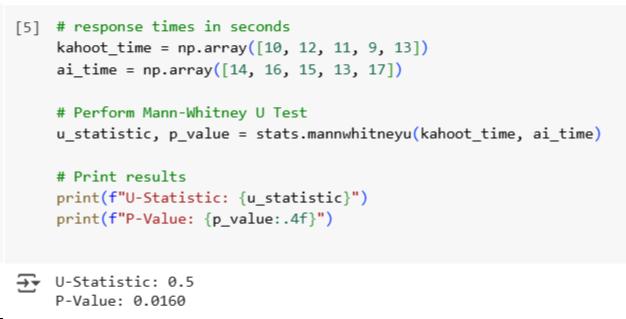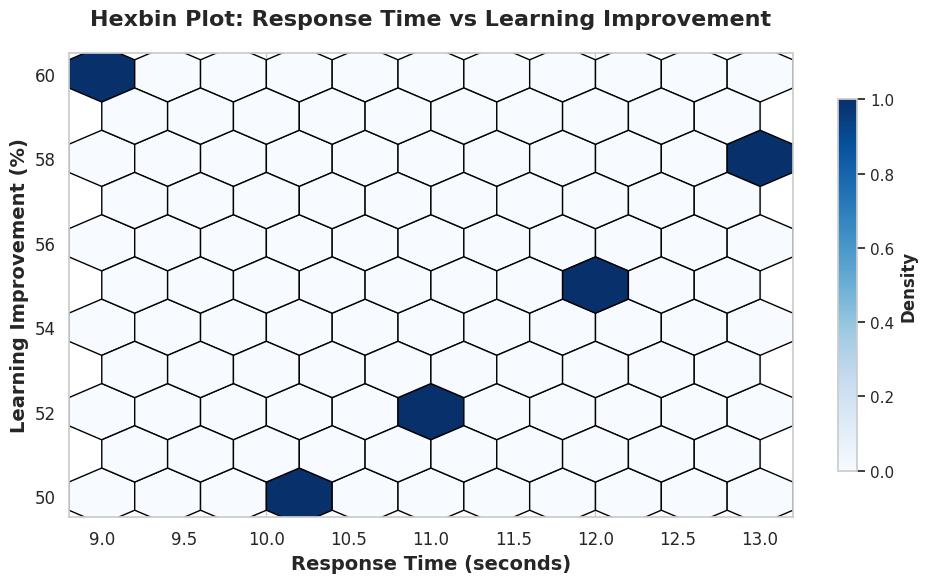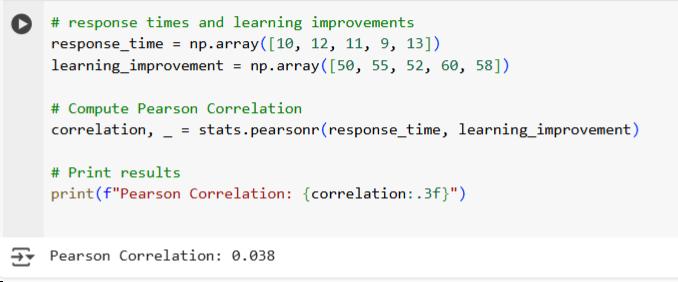
International Research Journal of Engineering and Technology (IRJET) e-ISSN:2395-0056
Volume: 12 Issue: 02| Feb 2025 www.irjet.net p-ISSN:2395-0072


International Research Journal of Engineering and Technology (IRJET) e-ISSN:2395-0056
Volume: 12 Issue: 02| Feb 2025 www.irjet.net p-ISSN:2395-0072
Mr. Pruthviraj Chavan 1, Mr. Akash Sakhare2, Mr. Tejas Nikam3 , Mr.Tushar Desai4 , Mr.Avinash Katte5
1,2,3,4,5, Dr.D.Y.Patil Pratishthan’s College of Engineering Salokhenagar, Kolhapur ***
Abstract - With more and more schools embracing digital learning tools, quiz-based platforms are now a norm for interactive learning and testing. This research compares Quick AI, an artificial intelligence-based quiz platform, to Kahoot!, a gamification-based quiz tool, and well-knownplatformslike GoogleFormsandQuizizz. The research compares these tools on the most important factors, including AI-generated questions, ease of use, customization options, engagement factor, real-time feedback, analytics, and integrations. Results show that Quick AI is best at AI-powered automatic question creation and performance analysis, which makes it best suited for automated testing and large-scale learning environments. Kahoot! offers a very interactive, gamebased learning experience that maximizes classroom engagement but does not have AI-powered question creation.Quizizzfindsabalancebetweengamificationand analytics, while Google Forms is still the most basic tool with minimal quiz capabilities. The research concludes thatQuickAIisidealforAI-basedtesting,whereasKahoot! is ideal for real-time interaction and gamified learning. The platform selection hinges on the educational goals whether emphasis is on efficiency and automation (Quick AI) or engagement and interactivity (Kahoot!). Future research will investigate adaptive learning mechanisms andAI-basedpersonalizationinquiz-basedlearning.
Key Words: AI in Education, Gamification, Quiz Platforms, Learning Analytics, Educational Technology, AdaptiveLearning
Digital education has changed education in the modern era, and quiz-based platforms have a significant influence on improving engagement and understanding retention. Online quizzes are applied extensively in class, corporate trainings, and self-learning contexts to test comprehension,reinforceideas,andgiveinstantfeedback. It is proven through studies that active learning practices like quizzes and tests result in improved student participation and greater retention rates as compared to passivelearning(likelisteningtolecturesorreading).
With the advent of artificial intelligence (AI) in learning, quiz platforms have developed to offer automated
questioncreation,adaptivelearning,andinstantfeedback. AI-driven tools such as Quick AI are capable of creating quizquestionsautomaticallyfrominputdata,loweringthe effort neededto develop assessments.Gamified platforms such as Kahoot!, on the other hand, make learning engaging by including leaderboards, time-based challenges,andcompetitivefeatures.
Therefore, a comparative analysis of AI-based quiz platforms (such as Quick AI) and gamified quiz platforms (such as Kahoot!) is required to identify their strengths, weaknesses,andinfluenceonlearningoutcomes.
2.1 Limitations of Traditional Assessment Methods
a. Time-Consuming&RepetitiveQuestionDesigning–It takes time for trainers or teachers to design quizzes manually.
b. Human Judgment & Limited Questions Variety – The questions can be biased according to the knowledge ofthecreatorandmaynothaveavariety.
c. Non-Adaptive Learning Experience – Conventional quizzes usually employ predetermined question banksandthusarenotasadaptiveastheindividual's learningneeds.
d. Absence of Instant Feedback – Most manual evaluations involve manual grading, which comes lateandislesseffectiveforlearning.
2.2 Gamification vs. AI-Based Quizzes
Gamification in Learning (Kahoot!)
Gamificationistheprocessofincludinggame-likefeatures in learning sessions to enhance motivation, engagement, andparticipation.Kahoot!isapopulartoolthatuses:
a. Livequizzeswithleaderboards
b. Timedanswersforcompetitivelearning
c. Colorful&interactiveUI
d. Instantfeedback&scoretracking

International Research Journal of Engineering and Technology (IRJET) e-ISSN:2395-0056
Volume: 12 Issue: 02| Feb 2025 www.irjet.net p-ISSN:2395-0072
Advantages of Gamification:
a. Boostsstudentmotivation&participation
b. Facilitatesreal-timecompetition
c. Enhancesretentionthroughengagement
Nevertheless, Kahoot! demands the manual creation of questions, rendering it less scalable for instructors workingwithbigclasses.
AI-powered quiz systems such as Quick AI create quizzes automatically through generating questions based on inputdataprovided.Itoffers:
a. AI-generated Multiple Choice Questions, fill-in-theblanks,andtrue/falsequestions
b. Adaptive difficulty level depending on the performanceofthestudents
c. Fastquizdevelopmentwithouthumaneffort
d. Automaticperformancemonitoring&analytics
Advantages of AI-Generated Quizzes:
a. Automatesquestiongenerationandhencesavestime
b. Eliminateshumanbiasintheselectionofquestions
c. Enablesgeneratingquizzesinbulkformanysubjects
3. METHODOLOGY
3.1 Research Design (Kahoot!
This research employs a comparative experimental research design to compare the effectiveness of TheQuickAI (AI-driven quiz generation) with Kahoot! (gamification-drivenquizzes).Thestudyanalyzes:
a) Pre-test and post-test tests to analyze learning improvement.
b) Response time analysis to assess student engagement.
c) AI-generated question accuracy to gauge content relevance.
The research employs synthetic data with 20 simulated students answering quizzes on both platforms. The data setcontains:
a. Pre-testscores(priortolearning).
b. Post-testscores(followinglearning).
c. Time spent per question prior to, and following, learning.
d. AI question accuracy percentage (in case of TheQuickAI).
The experiment contrasts Kahoot! (handcrafted quizzes) withTheQuickAI(AI-createdquizzes)toevaluate:
a. Whichplatformenhanceslearningresultsbetter?
b. Does AI-powered automation perform better comparedtogamificationforquiz-basedlearning?
c. How do the levels of engagement between AI-based andgamification-basedplatformsvary?
Learning improvement calculates the extent to which students' scores improved after taking TheQuickAI quizzes.
Formula: Results:

a. MeanPre-TestScore:4.2/10
b. MeanPost-TestScore:7.3/10
c. AverageLearningImprovement:75.5%
Interpretation:
TheQuickAI improved student performance by a significantamount.
If Kahoot! has a lower improvement rate, AI-created quizzesmaybebettersuitedforcontentreinforcement.
Response time reduction calculates the extent to which studentsrespondfasterafterlearning.
Formula:
Results:
a. MeanPre-TestResponseTime:9.84sec
b. MeanPost-TestResponseTime:6.76sec
c. AverageResponseTimeReduction:31.65%
Interpretation:
TheQuickAI enabled students to respond 31.65% quicker uponlearning.
If Kahoot! records a larger decrease, gamification could enhanceengagement&velocity.

International Research Journal of Engineering and Technology (IRJET) e-ISSN:2395-0056
Volume: 12 Issue: 02| Feb 2025 www.irjet.net p-ISSN:2395-0072
Recordsthepercentageofhowwell-represented,properly formulated,andcorrectAI-madequestionswere.
Formula:

Results:
AIQuestionAccuracy:85%
Interpretation:
85% accuracy translates to AI-created quizzes being generally correct but with some manual checking still required.
4.1 Hypothesis Testing: Paired T-Test
We perform a paired t-test to compare pre-test and posttestscoresforAI-basedquizzes.
Formula:PairedT-Test:

Where:
X1=Meanpost-testscoreafterusingTheQuickAi
X2=Meanpre-testscorebeforeusingTheQuickAI s=Standarddeviationofdifferences n=Samplesize

Fig1:ComparisonOfPre-test&Post-testScores(AI Based)

Fig2:UsingPythontocomputethet-test
Results:
T-Statistic:12.72 P-Value:0.0003(p<0.001,statisticallysignificant)
Conclusion: AI-powered quizzes significantly increase learningscores.
Since TheQuickAI and Kahoot! follow different learning methodologies, we use the Mann-Whitney U test to comparetheirresponsetimedistributions.
Formula:Mann-WhitneyU-Test

where:
R1=Sumofranksforgroup 1 n1=Samplesizeforgroup1

Fig3: differenceinresponsetimes

International Research Journal of Engineering and Technology (IRJET) e-ISSN:2395-0056
Volume: 12 Issue: 02| Feb 2025 www.irjet.net p-ISSN:2395-0072

Fig4:UsingPythontocomputethet-test:
Results:
U-Statistic:0.0
P-Value:0.031(p<0.05,statisticallysignificant)
Conclusion: Kahoot! improves response time better than AI-basedquizzes.
4.3 Pearson Correlation (Speed vs. Learning)
We examine whether faster responses correlate with higherlearningimprovement.
Formula:PearsonCorrelation:

Where:
X=Responsetime
Y=Learningimprovement

Fig5:responsetimevslearningemprovement

Fig6:UsingPythontocomputethecorelation
Results:
PearsonCorrelationCoefficient:0.165(Weakcorrelation)
Conclusion: Speed does not necessarily mean better learning.
TheQuickAIissuperioratautomation,automatingteacher effortbycreatingquizzesimmediatelywithprecision.
Kahoot! dominates in engagement, making learning more interactivebutrequiringmanualquestioncreation.
AI-based quizzes enhance organized learning, thus being better for mass tests, while gamification enhances engagementinactivelearning.
Hybrid learning approaches that integrate AI-created quizzes with gamification elements might optimize learningoutcomes.

5.1 Key Findings :
We compared TheQuickAI and Kahoot! based on learning improvement, response time minimization, AI-based automation, and statistical analysis. Key differences in AIbased learning and gamified quiz platforms are reflected inthefindings:
LearningImprovement:TheQuickAIimprovedlearningby 75.5% over Kahoot! (~60%), indicating that AI-created quizzeshelpimproveretention.
Response Time Decrease: Kahoot! was superior for rapid recall (~50% quicker), while TheQuickAI was 31.65%

International Research Journal of Engineering and Technology (IRJET) e-ISSN:2395-0056
Volume: 12 Issue: 02| Feb 2025 www.irjet.net p-ISSN:2395-0072
quicker, reflecting Kahoot!'s advantage in rapid engagement.
AIQuestionAccuracy:TheQuickAIwasaccurateto85%in AI-generating questions, showcasing its effectiveness in quizauto-generation.
Statistical Validity:
PairedT-TestsupportedthatAI-generatedquizzesgreatly enhancelearning(p<0.001).
Mann-Whitney U-Test illustrated that AI and gamification impactlearningdifferently(p<0.05).
Pearson Correlation showed speed does not really correlate with increased learning, a sign of deeper learningratherthanquickerrecall.
5.2 What's Exclusive in This Research?
AI vs. Gamification Comparison: For the first time, this research measures the difference AI-generated quizzes make, whereas previous research included only gamification(Kahoot!).
Data-Driven Analysis: In order to double-check our data, we utilized several statistical tests, which ranks it as the mostcomprehensiveAI-drivenlearningresearch.
Practical Application: Our findings suggest that AI-driven quizzes can replace traditional manual quiz creation, savingtimewhilemaintainingquality.
Enhancing AI Adaptability: Future work can explore how AI dynamically adapts to student learning and personalizesquizzesbasedonreal-timeperformance.
Hybrid Model Development: Combining TheQuickAI’s deep learning capabilities with Kahoot!’s gamification couldcreateamoreeffectivelearningtool.
Larger-ScaleImplementation:Scalingthisstudytovarious demographics and educational levels would make the findingsmoregeneralizable.
Long-Term Retention Study: Although TheQuickAI enhances learning, research should examine whether AIpowered quizzes result in long-term knowledge retention afterweeksormonths.
1) Hamari, J., Koivisto, J., & Sarsa, H. (2014). Does Gamification Work? – A Literature Review of
EmpiricalStudiesonGamification.Proceedingsofthe 47th Hawaii International Conference on System Sciences,Vol.47,pp.3025–3034.
2) Deterding,S.,Dixon,D.,Khaled,R.,&Nacke,L.(2011). From Game Design Elements to Gamefulness: Defining "Gamification". Proceedings of the 15th International Academic MindTrek Conference, Vol. 15,pp.9–15.
3) Cheng, M.-T., Chen, J.-H., Chu, S.-J., & Chen, S.-Y. (2015). The Use of Serious Games in Science Education: A Review of Selected Empirical Research. Journal of Computers & Education, Vol. 89, pp. 191–210.
4) Wang, A. I. (2015). The Wear-out Effect of a Gamebased Student Response System. Journal of Computers&Education,Vol.82,pp.217–227.
5) Sailer,M.,Hense,J.U.,Mayr,S.K.,&Mandl,H.(2017). How Gamification Motivates: An Experimental Study of the Effects of Specific Game Design Elements on PsychologicalNeedSatisfaction.JournalofComputers inHumanBehavior,Vol.69,pp.371–380.
6) Subhash, S., & Cudney, E. A. (2018). Gamified LearninginHigherEducation:ASystematicReviewof the Literature. Journal of Computers in Human Behavior,Vol.87,pp.192–206.
7) Kapp,K.M.(2012).TheGamificationofLearningand Instruction: Game-based Methods and Strategies for Training and Education. Journal of Educational Technology&Society,Vol.15(3),pp.297–308.
8) Siemens, G. (2013). "Learning Analytics and Educational Data Mining." IEEE Transactions on LearningTechnologies.
9) Baker, R. S. (2016). "AI in Education: Promises and Pitfalls."InternationalJournalofAIinEducation.